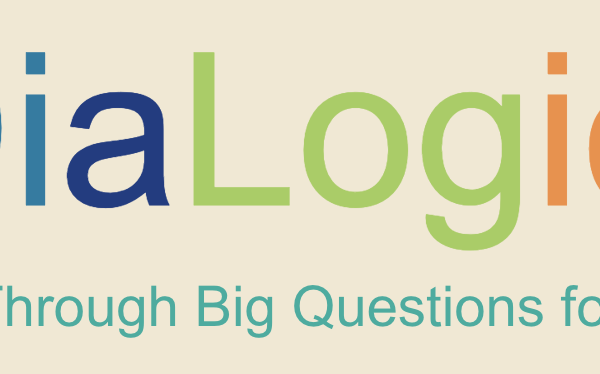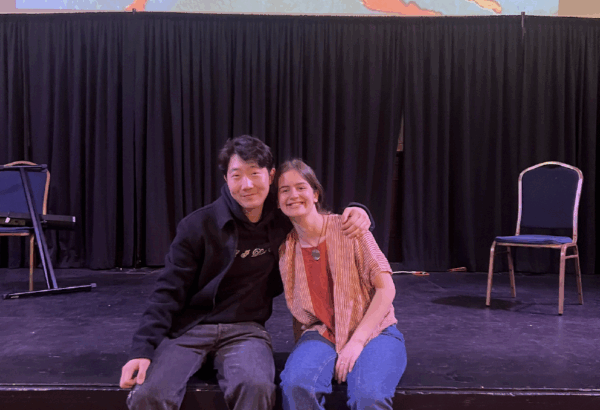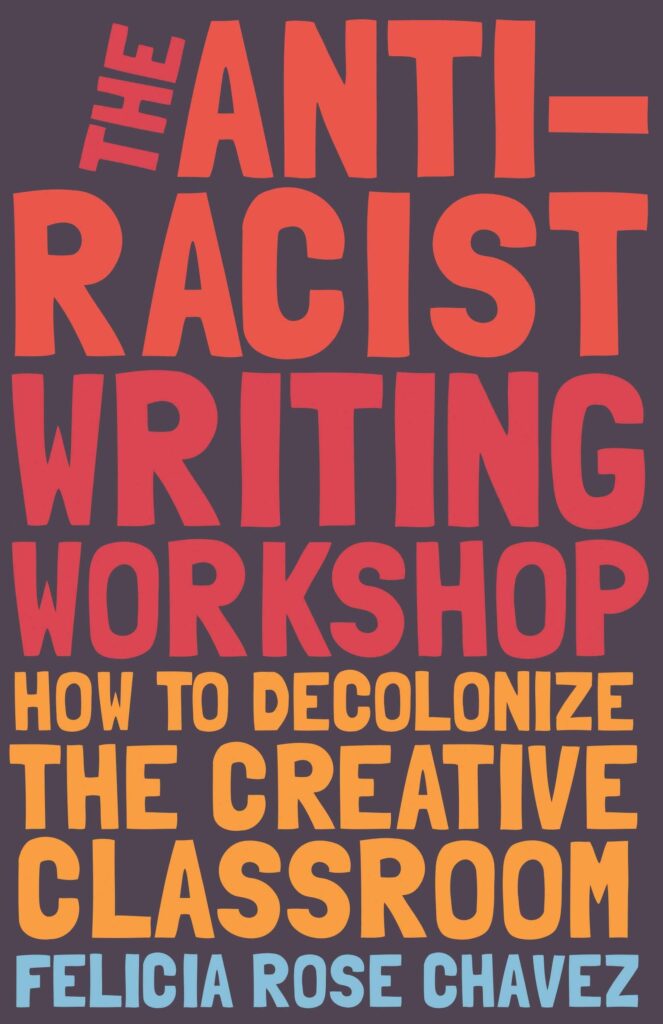
Overview of The Anti-Racist Writing Workshop
This week for the Decolonizing Dialogue reading series, I’m reading The Anti-Racist Writing Workshop: Decolonizing the Creative Classroom by Felicia Rose Chavez (2021).
(For an introduction to this blog series, see here; for other entries in the series, see “Sarah’s Content” on this page.)
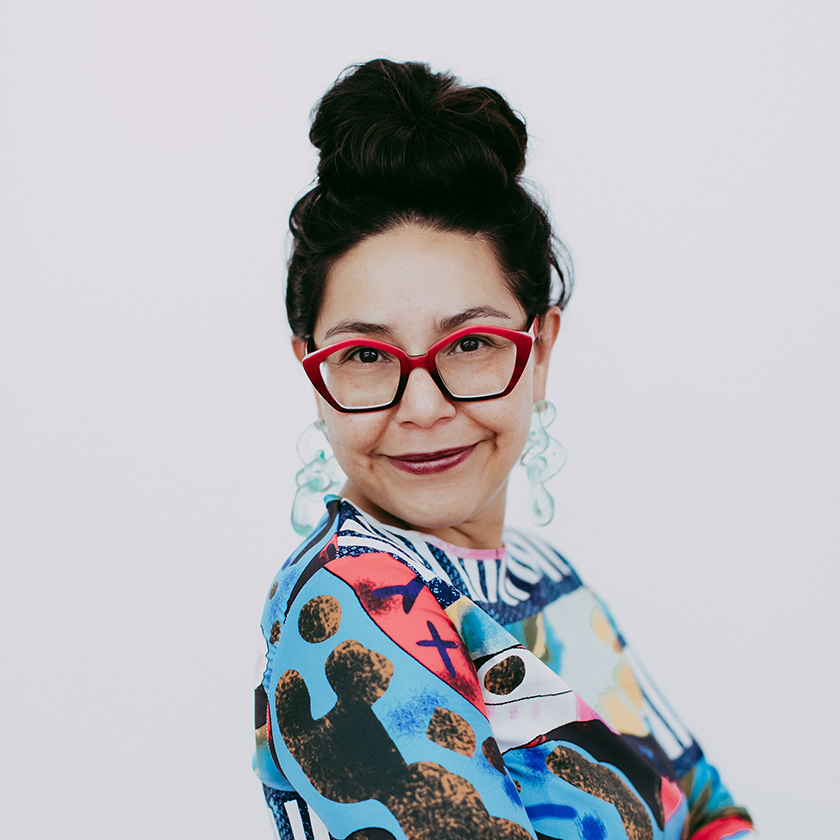
Felicia Rose Chavez is a writer and educator originally from Albuquerque, New Mexico. She holds an MFA in Creative Nonfiction from the celebrated University of Iowa Writers Workshop. However, Chavez writes in The Anti-Racist Writing Workshop, as a working-class, Chicana, and first-generation student, she felt profoundly alienated from her peers, her professors, and the content, format, and structure of her courses. Chavez’s experiences as a student at Iowa and other institutions informed her work as a teacher developing the anti-racist model she presents in the book. Currently, Chavez is the Bronfman Creativity and Innovation Scholar-in-Residence at Colorado College.
The video above features Chavez introducing The Anti-Racist Writing Workshop in her own words and voice. As she suggests in the video, the book interweaves memoir and manual. Chavez refers to deeply personal experiences as a student and professional experiments as a teacher to advocate for an approach to decolonizing the college classroom that starts with, but extends beyond, diversifying the voices present in the room, including the teacher(s), the students, and the course texts. Chavez argues that White supremacy expresses itself in higher education not only in the ways in which White perspectives are centered and falsely universalized as “neutral” in both scholarly and creative course materials, but also in a pedagogical approach based on “the ego of domination and control” (25). By this Chavez means a hierarchical, top-down style of teaching focused on affirming the teacher’s authority, expertise, and power through structures that disempower students and encourage competition among them — no matter what the teacher’s ethno-racial identity is. In contrast, Chavez advocates for anti-racist teaching as “a pedagogy of deep listening” in which students are co-creators of knowledge and content and participants in a supportive learning community:
“We invest in one another as complex individuals. We confront the voices in our heads that tell us our stories are unimportant. We honor the sidelined narratives of people of color, women, queer, differently abled, and gender-nonconforming artists. We listen to one another . . . ever conscious of our body language. We ask questions with the intent to understand instead of retort.” (17-18).
Though The Anti-Racist Writing Workshop is focused, as the subtitle indicates, on the “creative classroom,” I believe that the practices and mindsets that Chavez promotes are much more broadly applicable. They are adaptable to any classroom setting, including STEM and business fields. Chavez argues throughout the book that an anti-racist approach, in addition to providing critical and necessary support to students of color, benefits learners of all identities, privileged and oppressed alike. Similarly, I would suggest, Chavez’s approach to the writing workshop — characterized by Freireian dialogue, student-centered structures, and a plurality of voices and perspectives — deepens the pleasure and meaning of learning regardless of discipline or topic. And you don’t need to be a teacher, or have a teacher’s permission, to begin to implement some of these practices in your own learning, for your own benefit. They might even influence others’ learning, beginning to transform classrooms from the bottom up.
Major Concepts: Facing Fears, Student Ownership, and Self-Assessment
Here are some of the anchoring concepts from The Anti-Racist Writing Workshop. For each one, I’ve suggested a few questions, inviting you to dialogue with Chavez’s ideas through the lens of your own values, experiences, and goals.
Facing fears: Chavez emphasizes the importance of the class as a collective: a community of mutual support and generosity. Chavez characterizes anti-racist teaching as a form of mothering, which for her is an ungendered act that a person of any identity or status is capable of performing. It is fundamentally an extension of the self towards the other, defined by generosity in giving support in multiple forms and humble openness to learning from the other through dialogue. She explains, “‘Mothering’ our students by listening — allowing them to use their voices — is an act of humility, it’s an act of conspiring towards mutual learning. . . . Teaching is reciprocal” (52). Importantly, Chavez suggests that we all (whether student or teacher) can work actively to “mother” ourselves in this manner by developing mindfulness. By this she means turning inward, facing our fears related to the work we are doing, and asserting our determination to persist in the attempt anyway. In a section titled “Mothering Myself,” Chavez models an exercise that she has students do. She writes out a list of her own fears related to writing the book, including “I’m afraid that POC readers won’t take my ideas seriously because I’m not Chicana enough. I’m afraid that white selection committees won’t hire me as a result of writing this book. . . . I’m afraid that this book will not be good enough” and more. She ends the list by declaring, “But I will write anyway” (67).
- What is your first reaction to the concept of teaching as “mothering”? Have you ever experienced the kind of holistically nurturing teaching that Chavez describes? How did, or how do you think you would, respond to it?
- What are your fears related to the work you are doing, whether your academic work, your community-based work, or a professional position? What are your fears related to engaging in dialogue with people of different identities and/or beliefs? Have you ever reflected consciously on these fears before? Why, and how, do you persist in spite of your fears?
Student Ownership: Chavez stresses the importance of sharing power with students in determining the tone, content, and goals of the course, and she offers a number of concrete ways that this can be accomplished. Though her suggestions are directed at teachers, they are practices that students can adopt themselves in order to participate actively in their own learning. Through processes of critical reflection and supplementation — whether or not these processes are officially part of the course — you can (re)shape your own experience in a course. I’ve summarized three of her suggested practices below, with reflection questions after each one.
Audit the syllabus. Chavez offers a survey of questions for teachers to review their own curricula and evaluate their “hidden curriculum,” or “those personal principles so embedded in how [teachers] teach that [they] probably take them for granted” (45). Students can perform this survey to review syllabi and consider how they might advocate for change. Some of the questions, taken from pages 45-46 of the book and adapted for students, include:
- For whom does this course seem to be designed? In other words, what person seems to be the ideal student the instructor has imagined for this course?
- What norms and values seem to be informing the course’s objectives, texts, and assignments?
- Is there any evidence that this course reflects or includes reference to its geographic location at all, including subjugated histories, cultures, and languages?
- Is there any evidence that this course affirms the agency of people of color?
- Is there any evidence that this course requires White students to acquire the intellectual and cultural resources to function effectively in a plural society?
- Is there any evidence that this course will foster a community in which students learn actively from each other and draw on their own knowledge sources?
- Do the assessments and assessment criteria for this course include a variety of different ways by which students can demonstrate growth and proficiency? Do they draw on student strengths and promote their agency and creativity?
Supplement the text list. Chavez describes her courses’ text lists as “a living archive transformed into an inclusive learning tool” (103). This means that, rather than a reading list set in stone before the course’s beginning, she invites students to contribute additional texts beyond or instead of her initial selections. “In this radical take on the anthology,” Chavez writes, “every workshop participant contributes to our course of study” (104).
- Think of a class you are currently taking. Look at the reading list. Whose voices are missing? What perspectives are not represented that you believe are crucial to understand these topics more fully?
- Where could you find other texts that might represent some of those missing perspectives? Think: songs, poems, works of art, essays, memoir, news articles, op-eds, interviews, documentaries, TV episodes, etc.
- How would you share these supplemental texts with your teacher and classmates? How might you help create a supplementary “living archive” that others could contribute to?
Decode lectures and materials. As a student of color at various institutions, Chavez explains, “My history, my culture, my narrative were all interpreted through White bias and then explained back to me” (114). She talks about the extra labor that students of color often perform in order to “translat[e] white universality into multicultural reality” (115). By this she means a decoding process, often unconsciously performed, by which students must deconstruct their professor’s lectures in order to extract value and meaning despite the professor’s biases and omissions. Though this process is exhausting, Chavez writes, it is the means by which students of color are able “to reject the academy’s colonization of our consciousness [and] negotiate our belonging in a white supremacist capitalist patriarchy (otherwise known as college)” (115). As such, Chavez suggests that this decoding process is valuable critical thinking that all students should be encouraged to employ. Below are the components of this critical decoding, reproduced verbatim from page 115 of the book:
- What did the professor and/or the text say, exactly?
- To whom was this information tailored, and why?
- What else was communicated, either through omission or nonverbal body language?
- Can I separate my emotional response to what was communicated in order to access the required information?
- If not, am I able and/or willing to articulate my offense to the professor?
- Finally, how can I adapt this information to best serve my individual learning?
Self-Assessment: A system of total dependency in which students rely solely on their teachers’ assessment to determine what they’ve learned and how they feel about themselves is oppressive. Chavez advocates for teachers to create multiple ongoing opportunities for students to assess themselves — but even in the absence of such formal structures in a course, you can still assert ownership over your learning and find meaning in the work you are doing beyond the approval you receive from a “superior.” The graphic below presents seven ways to practice self-assessment as one proceeds through a course, a job, or a project in civic engagement. These have been adapted from page 174-75 of The Anti-Racist Writing Workshop. (Download a PDF at this link: 7 Ways to Self-Assess graphic. Access a plain-text version at this link: 7 Ways to Self-Assess plain-text.)
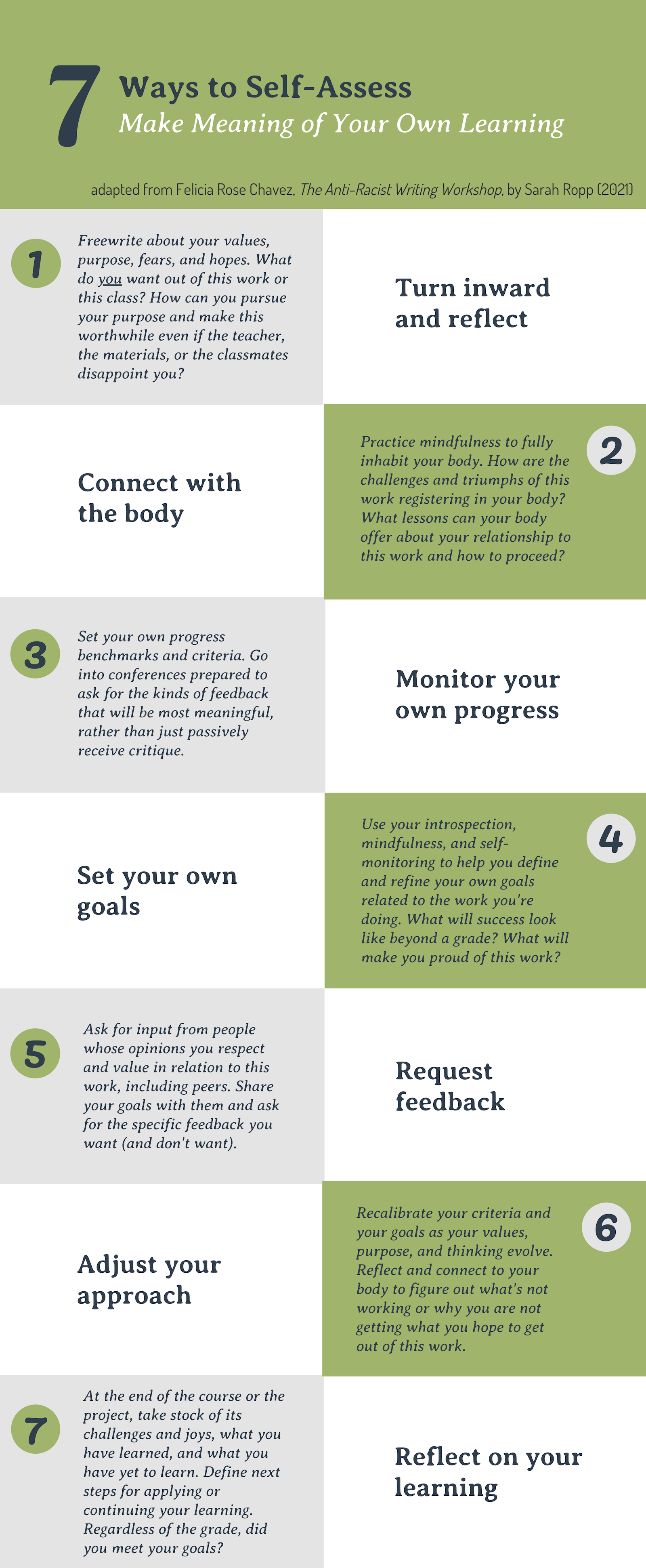
If you like this content and want more, follow us on social media and subscribe to our listserv.

